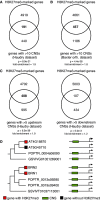The histone modification H3K27me3 is retained after gene duplication and correlates with conserved noncoding sequences in Arabidopsis
- PMID: 24567304
- PMCID: PMC3971591
- DOI: 10.1093/gbe/evu040
The histone modification H3K27me3 is retained after gene duplication and correlates with conserved noncoding sequences in Arabidopsis
Abstract
The histone modification H3K27me3 is involved in repression of transcription and plays a crucial role in developmental transitions in both animals and plants. It is deposited by PRC2 (Polycomb repressive complex 2), a conserved protein complex. In Arabidopsis thaliana, H3K27me3 is found at 15% of all genes. These tend to encode transcription factors and other regulators important for development. However, it is not known how PRC2 is recruited to target loci nor how this set of target genes arose during Arabidopsis evolution. To resolve the latter, we integrated A. thaliana gene families with five independent genome-wide H3K27me3 data sets. Gene families were either significantly enriched or depleted of H3K27me3, showing a strong impact of shared ancestry to H3K27me3 distribution. To quantify this, we performed ancestral state reconstruction of H3K27me3 on phylogenetic trees of gene families. The set of H3K27me3-marked genes changed less than expected by chance, suggesting that H3K27me3 was retained after gene duplication. This retention suggests that the PRC2-recruiting signal could be encoded in the DNA and also conserved among certain duplicated genes. Indeed, H3K27me3-marked genes were overrepresented among paralogs sharing conserved noncoding sequences (CNSs) that are enriched with transcription factor binding sites. The association of upstream CNSs with H3K27me3-marked genes represents the first genome-wide connection between H3K27me3 and potential regulatory elements in plants. Thus, we propose that CNSs likely function as part of the PRC2 recruitment in plants.
Keywords: CNS; PRC2; PRC2 recruitment; ancestral state reconstruction.
Figures




Similar articles
-
Comparative epigenomics in the Brassicaceae reveals two evolutionarily conserved modes of PRC2-mediated gene regulation.Genome Biol. 2017 Oct 31;18(1):207. doi: 10.1186/s13059-017-1333-9. Genome Biol. 2017. PMID: 29084582 Free PMC article.
-
H2A monoubiquitination in Arabidopsis thaliana is generally independent of LHP1 and PRC2 activity.Genome Biol. 2017 Apr 12;18(1):69. doi: 10.1186/s13059-017-1197-z. Genome Biol. 2017. PMID: 28403905 Free PMC article.
-
Contribution of the epigenetic mark H3K27me3 to functional divergence after whole genome duplication in Arabidopsis.Genome Biol. 2012 Oct 3;13(10):R94. doi: 10.1186/gb-2012-13-10-r94. Genome Biol. 2012. PMID: 23034476 Free PMC article.
-
The complexity of PRC2 catalysts CLF and SWN in plants.Biochem Soc Trans. 2020 Dec 18;48(6):2779-2789. doi: 10.1042/BST20200660. Biochem Soc Trans. 2020. PMID: 33170267 Review.
-
Chromatin modulation and gene regulation in plants: insight about PRC1 function.Biochem Soc Trans. 2018 Aug 20;46(4):957-966. doi: 10.1042/BST20170576. Epub 2018 Jul 31. Biochem Soc Trans. 2018. PMID: 30065110 Review.
Cited by
-
Phylogenetic profiling resolves early emergence of PRC2 and illuminates its functional core.Life Sci Alliance. 2022 Apr 19;5(7):e202101271. doi: 10.26508/lsa.202101271. Print 2022 Jul. Life Sci Alliance. 2022. PMID: 35440471 Free PMC article.
-
The histone modification H3 lysine 27 tri-methylation has conserved gene regulatory roles in the triplicated genome of Brassica rapa L.DNA Res. 2019 Oct 1;26(5):433-443. doi: 10.1093/dnares/dsz021. DNA Res. 2019. PMID: 31622476 Free PMC article.
-
Characterization and functional analysis of conserved non-coding sequences among poaceae: insights into gene regulation and phenotypic variation in maize.BMC Genomics. 2025 Jan 20;26(1):46. doi: 10.1186/s12864-025-11221-9. BMC Genomics. 2025. PMID: 39833673 Free PMC article.
-
In situ dissecting the evolution of gene duplication with different histone modification patterns based on high-throughput data analysis in Arabidopsis thaliana.PeerJ. 2021 Jan 5;9:e10426. doi: 10.7717/peerj.10426. eCollection 2021. PeerJ. 2021. PMID: 33505781 Free PMC article.
-
Comparative epigenomics in the Brassicaceae reveals two evolutionarily conserved modes of PRC2-mediated gene regulation.Genome Biol. 2017 Oct 31;18(1):207. doi: 10.1186/s13059-017-1333-9. Genome Biol. 2017. PMID: 29084582 Free PMC article.
References
MeSH terms
Substances
LinkOut - more resources
Full Text Sources
Other Literature Sources

